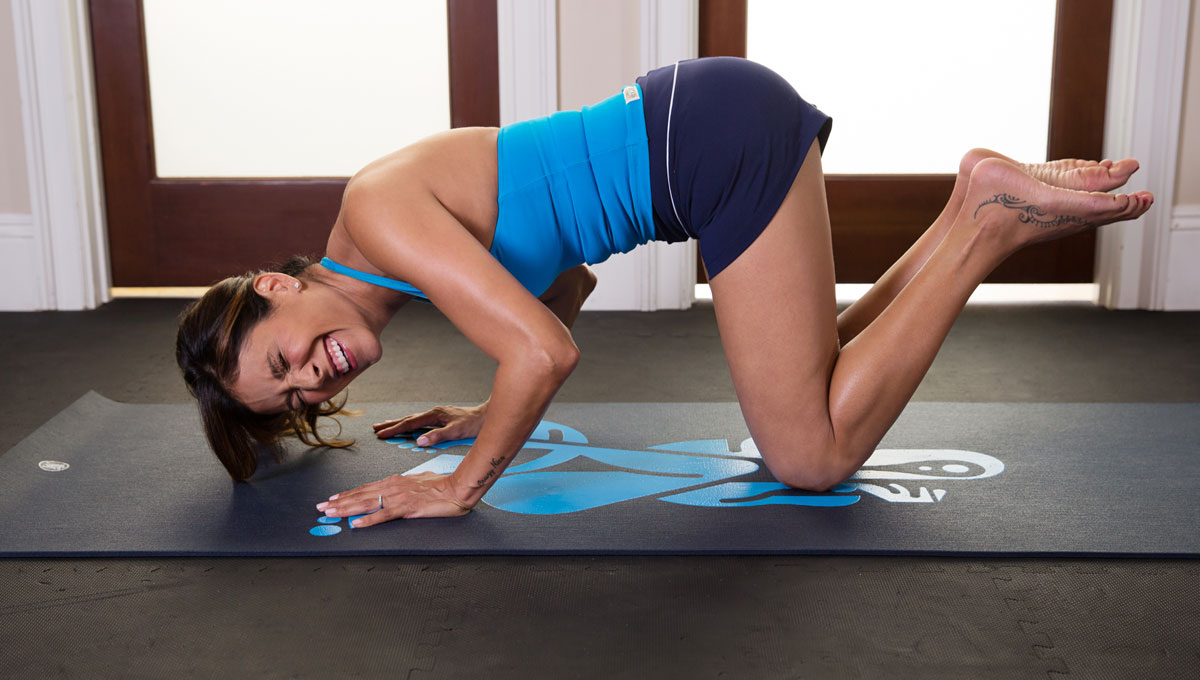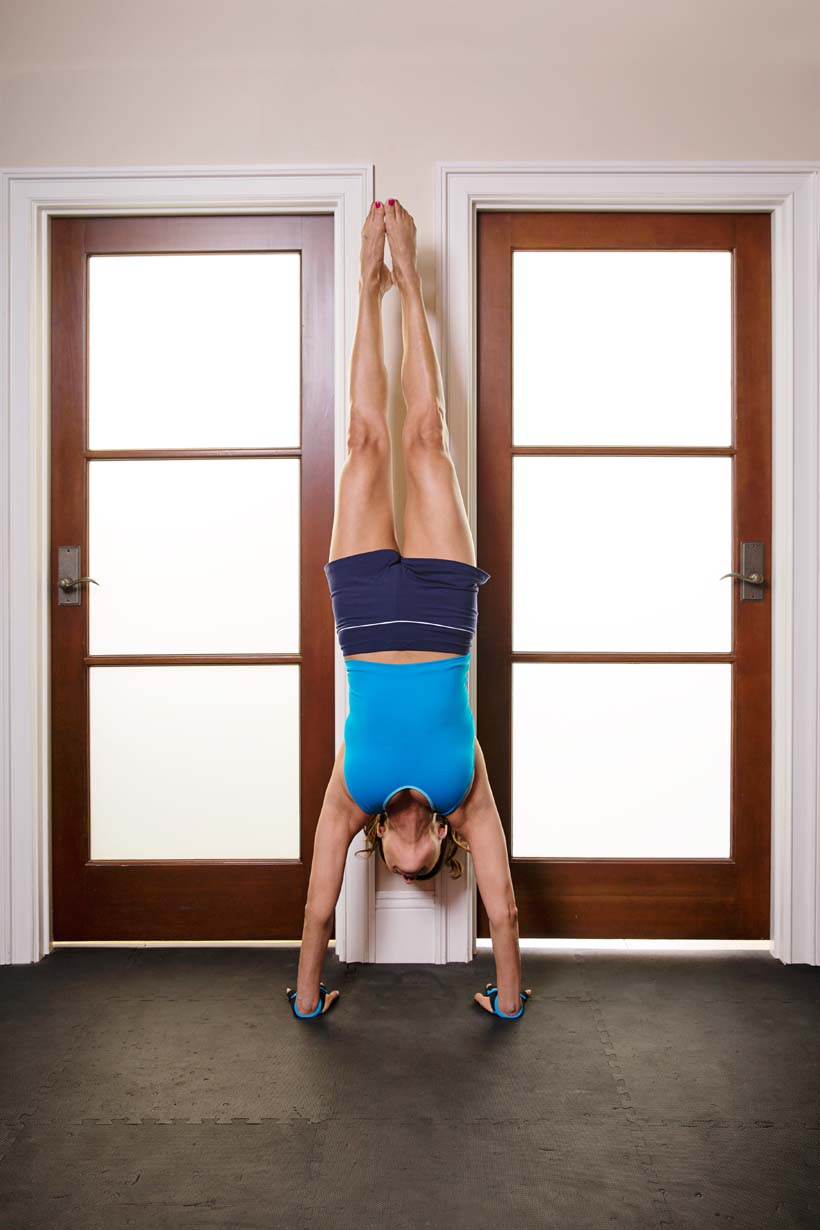
Desi Bartlett photographed by Fluid Frame Photography
Train Like a Yogi and Integrate strength training into your practice to find the core of the bandhas.
When we consider the practice of modern yoga, we can consider using all the tools available to us from the equipment at the gym to techniques from physical therapy, physical fitness, and strength training.
Using everything available to us in the context of yoga can help us to be more intelligent in how we use our body in practice. I have seen first-hand how strength training can help with some of the more challenging asanas. Strength training gives power to our larger muscle groups for strong poses like handstands. Done with awareness, strength training can also help us become more adept at yoga’s subtle effects. One of the most subtle and important actions that we enjoy in yoga is the ability to engage our bandhas.
Bandhas, Fitness, Strength, and Yoga
The Sanskrit word bandha translates as ‘lock.’ In the West, the bandhas that we most often speak of are mula bhanda (root lock), and uddiana bandha (abdominal lock). There is a third bandha less commonly practiced, at the jaw (jalandhara bandha); and the fourth, which is engaging all three bandhas (maha bandha).
Mula bandha refers to the root lock. Some systems describe this as being similar to a Kegel exercise (controlling the pubococcygeus muscle or PC muscle as you might when you need to urinate). There is a very clear sense of lifting the muscles of the pelvic floor when practicing the root lock. During advanced breathing exercises, this lift can be experienced as a subtle heat that helps to contain the energy in the body at the root. If this sounds a bit elusive, it can feel that way in yoga too. The exercise I have found that helps to teach this pelvic floor lift is borrowed from the worlds of fitness and physical therapy.
The Swiss ball has many names: physio ball, stability ball, even birthing ball. Originally it began its life as a physical therapy tool in Switzerland, and has made its way into American gyms as an effective device for training the stabilizers of the body. By sitting and bouncing on the Swiss ball while keeping your feet hooked under it, you can feel a contraction in your hamstrings. After about five or six jumps, you can also locate a feeling of ‘lifting’ in your pelvic floor. You have to lift the muscles of the pelvic floor to get an effective bounce. This is a way to experience what the muscles should be doing when practicing mula bandha.
Rather than sitting calmly and imagining the pelvic floor muscles lifting (which usually leads to making funny faces), you can feel the lift and apply it to your jumps in vinyasa class or practice. When the instructor says “engage mula bandha,” or “lift your pelvic floor,” or the even more challenging cue, “float into chaturanga,” you will know which muscles to lift and how, by feeling them while enjoying the ball exercise. I say “enjoying” intentionally, because it really is a lot of fun to bounce on the ball.
Uddiyana Bandha and the Ab Sling
Uddiyana bandha refers to the lock that is created at the abdomen. The word uddiyana means to “fly up.” Again, this is a concept that can feel a little intangible. How exactly are we supposed to feel our belly fly up and lock? For those who have started to practice different pranayama techniques, you have probably begun to notice that at the end of the exhalation, there is a feeling of lifting the lower abdomen up and in. At the end of an exhalation, the diaphragm moves up (to help push the air out), and our deeper belly muscles (the transverse abdominis or TVA) contract in so there is a sensation of the waist being smaller and the breath moving up and out. I have found that there is an exercise that we practice at the gym that can help us to feel this lift and contraction of the waist muscles. The ab sling has been around for many years and is a great way to train to feel uddiyana bandha.
With the ab sling attached to a stable/fixed bar, you can place your upper arms in the slings and hold on with your hands. Exhale, and lift your knees towards your chest. You can also take the knees side to side.
In the gym this is used to train the TVA, the rectus abdominis (six-pack muscles), and the obliques. You can apply this type of training as a functional exercise for handstands, jump backs, and the jump through to a seated position. In order to effectively float forward and back in your vinyasa practice, the deeper belly muscles have to be trained to contract at the end of your exhalation. That is why you will hear your yoga teacher saying something like “empty all of the breath and then jump to the front of the mat.”
While some purists may say that we need to practice more pranayama to learn the bandhas, there are absolutely ways that we can train our anatomy to support these actions.
Functional Test
Once you feel comfortable with the jump on the ball and the ab sling exercise, you can test your ability to engage your bandhas with a traditional pull-up at the gym. Find a fixed/stable bar at the gym or your local park. Place your hands (facing you to recruit your biceps) a little wider than shoulder’s distance apart and lift your chin towards the bar. Inhale as you straighten your arms and lower your body. Exhale and lift your body again.
Notice how the top of the movement is the end of the exhalation, and that is your prime opportunity to feel the lift in the pelvic floor and the lift and contraction of the abdomen. Once you can feel these actions, you have begun to support the anatomical actions that house the energy of the bandhas.
Bonus Movement for Our Modern World
While the ancient yogis of the texts were exploring the inner worlds of bandhas and pranayama, modern yogis have the added postural stress of present-day life. We drive in cars, work at computers, and lean forward a lot more as a result of longer windows of sitting.
The TRX row can work to strengthen the rhomboids which help us to stand up straight. It is also a movement that can strengthen the mid-trapezius and build stability for upward rotation of the scapula. Just like backbends can be a counter pose for hunching over, the row can train and strengthen the muscles of the mid-back to provide stability.
For the TRX back row, keep your body straight and lean back to approximately a 45 degree angle with the floor. Using an overhand grip, row the handles back towards your shoulders, feeling your shoulder blades moving in towards your spine. Repeat for three to four sets of 12-15 reps remembering to exhale on the exertion, which in this case refers to the shoulder blades drawing back and together.

Photo of Desi Bartlett by Fluid Frame Photography
Putting it all together in Handstand
Handstands are not just asana gymnastics. They are a prime opportunity to apply your strength and knowledge of bandhas. Begin with your hands shoulder width apart. Take a deep breath in and out. At the end of your exhalation, float (or slow kick with control) up into your handstand. At the end of each exhalation, feel the pelvic floor lifting (in this case towards your head because you are upside down).
At the same time, feel the deeper belly muscles draw in and support the lift. The pelvic floor muscles and the deeper abdominal muscles interdigitate, meaning that they connect sort of like interlaced fingers. When you find the relationship between the breath and the bandhas, floating is a lot more fun and you can play with variations.

Photo of Desi Bartlett in Handstand by Fluid Frame Photography
Integration
Movement is medicine. Movement brings strength, encourages flexibility, increases endurance, and establishes sustainable posture. Yoga gives us the gift of going within and finding inner strength and peace, in addition to powerfully training our tonic muscles; the muscles responsible for long holds and posture. A program of mind-body fitness gives us the amazing benefit of functional strength. We can train for our daily activities in a way that allows us to apply that strength and remain empowered in all that we do.
Fitness activities—specifically weight training—train the phasic muscles of our body, which are the muscles responsible for short bursts of activity and heavy lifting. By uniting the strength training techniques found in the fitness world with the breath, awareness, posture, and meditative techniques of yoga, we reap the benefits of training both the tonic and phasic systems, which provides a balanced means of being in the body. It’s also fun to play in the gym and bring that spirit of play into our work with bandhas and then into our inversion practice.
Desi Bartlett MS, CPT, has been teaching health and wellness for more than 20 years. Originally from Chicago, she has a degree in kinesiology and her master’s degree in corporate fitness. Desi holds advanced certifications in Yoga, personal training, group fitness, and is a certified pre- and post-natal fitness specialist.
